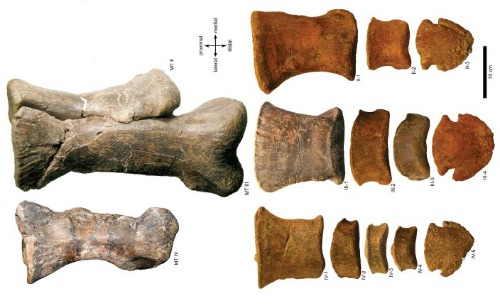Sometimes, hadrosaurs can be a real pain. Even though they are some of the most abundant dinosaurs among Late Cretaceous fossil sites, and are therefore an excellent resource for investigating the biology of dinosaurs, the fact is that there are far more isolated bits and pieces of them than complete skeletons. Properly identifying and cataloging these single bones can be difficult—you need a comprehensive knowledge of dinosaur anatomy to know what a lonely bone once belonged to. Now students Rachel Zheng and Gy-Su Kim from southern California’s Webb Schools and paleontologist Andy Farke have taken a step towards offering their colleagues a way to recognize isolated bones from hadrosaurine dinosaurs.
Zheng, Farke, and Kim have just published a hadrosaur atlas in PalArch’s Journal of Vertebrate Palaeontology. Their aim was to fill in a gap in the literature. Even though lots of hadrosaurs have previously been described, seemingly no one had published a detailed, illustrated guide to the hadrosaur foot.
To remedy this, the researchers decided to compose a detailed description of the well-preserved foot of a specimen tentatively attributed to the common Late Cretaceous hadrosaur Edmontosaurus annectens. With this atlas to the hadrosaur foot, they propose, other researchers and collections managers may be better able to properly identify hadrosaur foot bones, especially if those researchers don’t already have a reference collection to make comparisons with.
Frustratingly, the precise identity of the dinosaur used to create the atlas is uncertain. Hadrosaurs are notoriously difficult to identify without their skulls, and the specimen in question was missing one. Nevertheless, a combination of anatomical and geological detail allow Zheng, Farke and Kim to hypothesize that the dinosaur in their atlas is an Edmontosaurus annectens.
Along with the foot and other bones, part of the right hip (the ischium) of the dinosaur was found. The distal tip of this hip bone is narrow, and this feature identifies the dinosaur as belonging to the hadrosaurine lineage of hadrosaurs. (The other major hadrosaur lineage—the ornately-crested lambeosaurines—had a flared ischium tip.) Since Edmontosaurus annectens is the only hadrosaurine dinosaur known from the Hell Creek strata where this specimen was uncovered, the identification is the most reasonable one on the basis of the material at hand.
The bulk of the paper consists of labeled color photographs of the hadrosaur’s foot from different angle. This is not the super-sexy kind of research that’s going to end up in Nature or Science. That’s a good thing. Some of the biggest gaps in our understanding about dinosaurs involve relatively simple things. There is a definite need for detailed descriptions and comprehensive atlases that will allow other researchers to easily compare and identify different dinosaurs. I love paleobiology and wondering about the lives of dinosaurs as much as anybody else, but in order to generate hypotheses we need a solid foundation of descriptive analysis. I certainly hope that other researchers take the time to go through their own collections, identify well-preserved specimens, and create similar guides so that various mystery bits scattered through museums can be better identified and cataloged.
For more information related to dinosaurs, visit rareresource.com.
A Detailed Guide to a Hadrosaur’s Foot
Posted by Dinosaurs World at 9:04 PMMonday, December 5, 2011
Subscribe to:
Post Comments (Atom)

0 comments:
Post a Comment